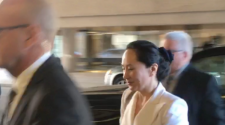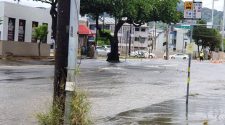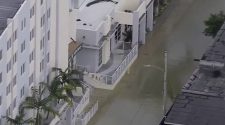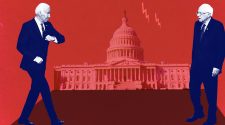Network Theory
John Baez

Scientists and engineers use diagrams of networks in many different
ways. Together with many collaborators I am studying networks with
the tools of modern mathematics, such as category theory. You can
read blog articles,
papers and a book about our research. I am
collaborating with the Topos Institute to
use the resulting math for
scientific
computation, such as quickly adaptable models of infectious disease.
Papers
Here are papers, theses, and a book:
Overview:
-
Brendan Fong, The Algebra
of Open and Interconnected Systems, Ph.D. thesis, University of
Oxford, 2016. (Blog article here.) -
Jason Erbele, Categories in
Control: Applied PROPs, Ph.D. thesis, U. C. Riverside, 2016. -
Blake Pollard, Open Markov
Processes and Reaction Networks, Ph.D. thesis, U. C. Riverside,
2017. -
Brandon Coya, Circuits,
Bond Graphs, and Signal-Flow Diagrams: A Categorical Perspective,
Ph.D. thesis, U. C. Riverside, 2018. (Blog article here.) -
Kenny Courser, Open Systems: a
Double Categorical Perspective, Ph.D. thesis, U. C. Riverside,
2020. (Blog articles here.) -
Jade Master, Composing
Behaviors of Networks, Ph.D. thesis, U.C. Riverside, 2021. -
John Baez and Jacob Biamonte, Quantum
Techniques for Stochastic Mechanics, World Scientific, Singapore,
2018. (Blog articles here.)
Classical mechanics:
Electrical circuits:
Control theory:
Markov processes:
-
John Baez and Brendan Fong,
A Noether theorem for Markov processes, Journal of Mathematical Physics 54 (2013), 013301. (Blog article here.) -
John Baez, Brendan Fong and Blake S. Pollard,
A compositional framework for
Markov processes, Journal of Mathematical Physics
57 (2016), 033301. (Blog article here.) -
Blake S. Pollard, A
Second Law for open Markov processes, Open
Systems and Information Dynamics 23 (2016), 1650006.
(Blog article here.) -
Blake S. Pollard, Open Markov
processes: A compositional perspective on non-equilibrium steady
states in biology, Entropy 18 (2016), 140.
(Blog article here.) -
John Baez and Kenny Courser,
Coarse-graining open
Markov processes, Theory and Applications of Categories
33 (2018), 1223–1268. (Blog article here.)
Reaction networks:
-
John Baez, Quantum techniques for
reaction networks, Advances in Mathematical Physics 2018 (2018), 7676309.
(Blog article
here.) -
John Baez and Brendan Fong,
Quantum techniques for studying equilibrium in reaction networks,
Journal of Complex Networks 3 (2014), 22–34.
(Blog article
here.) -
John Baez and Blake S. Pollard, A
compositional framework for reaction networks,
Reviews in Mathematical Physics 29 (2017), 1750028.
(Blog article here.) -
John Baez, Jonathan Lorand, Blake S. Pollard and Maru Sarazola,
Biochemical coupling through emergent conservation laws. (Blog articles here.)
Petri nets:
-
John Baez and Jade Master,
Open Petri nets.
(Blog articles here.) -
Jade Master, Petri nets based on
Lawvere theories, Mathematical Structures in Computer Science
30 (2020), 833–864 -
John Baez, John Foley and Joe Moeller, Network models from Petri nets with
catalysts, Compositionality 1, 4 (2019). (Blog article
here.) -
Categories of nets,
with Fabrizio Genovese, Jade Master and Michael Shulman. (Blog article
here.)
Stock-flow diagrams:
Graphs and quantale-valued matrices:
The mathematics of networks – decorated cospans:
-
Brendan Fong, Decorated
cospans, Theory and Applications of Categories 30 (2015),
1096–1120. (Blog articles here
and here.) -
Brendan Fong, Decorated
corelations, Theory and Applications of Categories 33
(2018), 608–643. -
Kenny Courser, A bicategory
of decorated cospans, Theory and Applications of Categories 32 (2017), 985–1027. (Blog article here.) -
Daniel Cicala, Spans of
cospans, Theory and Applications of Categories 33 (2018),
131–147. -
Daniel Cicala and Kenny Courser, Spans of cospans in a topos, Theory and Applications of Categories
33 (2018), 1–22.
The mathematics of networks – structured cospans:
- John Baez and Kenny Courser, Structured cospans, Theory and Applications of Categories, 35 (2020), 1771–1822. (Blog article here.)
- Daniel Cicala, Rewriting Structured Cospans: a Syntax for Open Systems, Ph.D. thesis, U.C. Riverside, 2019.
- Kenny Courser, Open Systems: a Double Categorical Perspective, Ph.D. thesis, U. C. Riverside, 2020. (Blog articles here.)
-
John Baez, Kenny Courser and Christina Vasilakopoulou,
Structured versus
decorated cospans, Compositionality 4, 3 (2022).
The mathematics of networks – props:
Blog articles
Here is the main series of blog articles:
You can navigate forwards and back through these using the blue
arrows. By clicking the links that say “on Azimuth”, you can see blog
entries containing these articles. Those let you read comments about
my articles—and also make comments or ask questions of your own!
Chemical reaction networks, Petri nets and
Markov processes
-
Part 1 – toward a general theory of networks.
Also available on Azimuth. - Part 2 – stochastic Petri nets; the master equation versus the rate equation. Also available on Azimuth.
- Part 3 – the rate equation of a stochastic Petri net, and applications to chemistry and infectious disease. Also available on Azimuth.
- Part 4 – the master equation of a stochastic Petri net, and analogies to quantum field theory. Also available on Azimuth.
- Part 5 – the stochastic Petri net for a Poisson process; analogies between quantum theory and probability theory. Also available on Azimuth.
- Part 6 – the master equation in terms of annihilation and creation operators. Also available on Azimuth.
- Part 7 – a stochastic Petri net from population biology whose rate equation is the logistic equation; an equilibrium solution of the corresponding master equation. Guest post by Jacob Biamonte. Also available on Azimuth.
- Part 8 – the rate equation and master equation of a stochastic Petri net; the role of Feynman diagrams. Also available on Azimuth.
- Part 9 – the Anderson–Craciun–Kurtz theorem, which gives equilibrium solutions of the master equation from complex balanced equilibrium solutions of the rate equation; coherent states. Joint post with Brendan Fong. Also available on Azimuth.
- Part 10 – an example of the Anderson-Craciun-Kurtz theorem. Also available on Azimuth.
- Part 11 – a stochastic version of Noether’s theorem. Joint post with Brendan Fong. Also available on Azimuth.
- Part 12 – comparing quantum mechanics and stochastic mechanics. Also available on Azimuth.
- Part 13 – comparing the quantum and stochastic versions of Noether’s theorem. Also available on Azimuth.
- Part 14 – an example: chemistry and the Desargues graph. Also available on Azimuth, together with a special post on answers to the puzzle.
- Part 15 – Markov processes and quantum processes coming from graph Laplacians, illustrated using the Desargues graph. Also available on Azimuth.
- Part 16 – Dirichlet operators and electrical circuits made of resistors. Also available on Azimuth.
- Part 17 – reaction networks versus Petri nets; the deficiency zero theorem. Joint post with Jacob Biamonte. Also available on Azimuth.
- Part 18 – an example of the deficiency zero theorem: a diatomic gas. Joint post with Jacob Biamonte. Also available on Azimuth
- Part 19 – an example of Noether’s theorem and the Anderson–Craciun–Kurtz theorem: a diatomic gas. Joint post with Jacob Biamonte. Also available on Azimuth.
- Part 20 – Dirichlet operators and the Perron–Frobenius theorem. Guest post by Jacob Biamonte. Also available on Azimuth.
- Part 21 – warmup for the proof of the deficiency zero theorem: the concept of deficiency. Also available on Azimuth.
- Part 22 – warmup for the proof of the deficiency zero theorem: reformulating the rate equation. Also available on Azimuth.
- Part 23 – warmup for the proof of the deficiency zero theorem: finding the equilibria of a Markov process, and describing its Hamiltonian in a slick way. Also available on Azimuth.
- Part 24 – proof of the deficiency zero theorem. Also available on Azimuth.
- Part 25 – Petri nets, logic, and computation: the reachability problem for Petri nets. Also available on Azimuth.
- Part 26 – Using chemical reactions for computation—an introduction by Luca Cardelli. Also available on Azimuth.
This was the official end of the series of posts on stochastic Petri nets and chemical reaction networks. All this material was made into a book:
But there is more to read:
-
The Large-Number Limit for Reaction Networks (Part 1) –
How the large-number limit for reaction networks resembles the
classical limit of quantum mechanics. This post is based on joint
work with Arjun Jain. Available on Azimuth. -
The Large-Number Limit for Reaction Networks (Part 2) –
Coherent states and the large-number limit. This post is based on
joint work with Arjun Jain. Available on
Azimuth. -
The Large-Number Limit for Reaction Networks (Part 3) – Deriving the
rate equation from the master equation by taking the large-number limit.
Joint with Arjun Jain. Available
on Azimuth.
There’s also a series of posts on this paper, which concerns coupled
reactions and conservation laws:
Here’s the series:
Electrical circuits
Starting in part 27 of the network theory series, I changed topics to
electrical circuits and related engineering problems. My series of blog
posts fizzled out after 5 more posts, since my students and I got busy
writing papers. But here they are:
- Part 27 – Getting differential equations from circuit diagrams. Available on Azimuth.
-
Part 28 – The analogy between electronics and mechanics. Available
on Azimuth. -
Part 29 – Analogies between the mechanics of translation, the mechanics
of rotation, electronics, hydraulics, thermal physics, chemistry,
heat flow and economics. Flow versus effort. Available
on Azimuth. -
Part 30 – Toward a category with circuits as morphisms. Available
on Azimuth, along with a videotaped lecture on YouTube. -
Part 31 – Circuits as cospans, and how to compose cospans. Available
on Azimuth and on YouTube.
These ended rather prematurely when I decided to focus on writing
papers instead. So, read some of the papers on circuits listed above
— or at least these theses, which make a great overview:
-
Brendan Fong, The Algebra
of Open and Interconnected Systems, Ph.D. thesis, University of
Oxford, 2016. (Blog article here.) -
Brandon Coya, Circuits,
Bond Graphs, and Signal-Flow Diagrams: A Categorical Perspective,
Ph.D. thesis, U. C. Riverside, 2018. (Blog article here.)
To understand ecosystems, ultimately will be to understand networks. –
B. C. Patten and M. Witkamp

Text © 2020 John Baez
[email protected]












